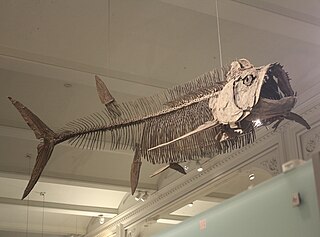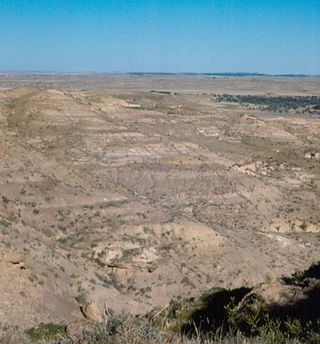
Meniscoessus is a genus of extinct multituberculates from the Upper Cretaceous Period that lived in North America.

The order Peramelemorphia includes the bandicoots and bilbies. All members of the order are endemic to Australia-New Guinea and most have the characteristic bandicoot shape: a plump, arch-backed body with a long, delicately tapering snout, very large upright ears, relatively long, thin legs, and a thin tail. Their size varies from about 140 grams up to 4 kilograms, but most species are about one kilogram.

Pterygotus is a genus of giant predatory eurypterid, a group of extinct aquatic arthropods. Fossils of Pterygotus have been discovered in deposits ranging in age from Middle Silurian to Late Devonian, and have been referred to several different species. Fossils have been recovered from four continents; Australia, Europe, North America and South America, which indicates that Pterygotus might have had a nearly cosmopolitan (worldwide) distribution. The type species, P. anglicus, was described by Swiss naturalist Louis Agassiz in 1839, who gave it the name Pterygotus, meaning "winged one". Agassiz mistakenly believed the remains were of a giant fish; he would only realize the mistake five years later in 1844.

Xiphactinus, colloquially referred to as the X-fish, is an extinct genus of large predatory marine bony fish that lived during the late Albian to the late Maastrichtian. The genus grew up to 5–6 metres (16–20 ft) in length, and superficially resembled a gargantuan, fanged tarpon.

The Lance (Creek) Formation is a division of Late Cretaceous rocks in the western United States. Named after Lance Creek, Wyoming, the microvertebrate fossils and dinosaurs represent important components of the latest Mesozoic vertebrate faunas. The Lance Formation is Late Maastrichtian in age, and shares much fauna with the Hell Creek Formation of Montana and North Dakota, the Frenchman Formation of southwest Saskatchewan, and the lower part of the Scollard Formation of Alberta.

Diatomyidae is a family of hystricomorph rodents. It is represented by a single living species, Laonastes aenigmamus, native to Laos in Southeast Asia. Fossil species are known from the Oligocene and Miocene of Asia and eastern Europe.

Rhynchippus is an extinct genus of notoungulate mammals from the Late Oligocene of South America. The genus was first described by Florentino Ameghino in 1897 and the type species is R. equinus, with lectotype MACN A 52–31. Fossils of Rhynchippus have been found in the Agua de la Piedra and Sarmiento Formations of Argentina, the Salla and Petaca Formations of Bolivia, the Tremembé Formation of Brazil, and the Moquegua Formation of Peru.

Dendrerpeton is a genus of an extinct group of temnospondyl amphibians. Its fossils have been found primarily in the Joggins Formation of Eastern Canada and in Ireland. It lived during the Carboniferous and is said to be around 309–316 million years of age, corresponding to more specifically the Westphalian (stage) age. Of terrestrial temnospondyl amphibians evolution, it represents the first stage. Although multiple species have been proposed, the species unanimously recognized is D. acadianum. This species name comes from “Acadia” which is a historical name for the Nova Scotia region as a French colony. It refers to the location of the coal field at which the fossil was found.

Kolponomos is an extinct genus of carnivoran mammal that existed in the Late Arikareean North American Land Mammal Age, early Miocene epoch, about 20 million years ago. It was likely a marine mammal. The genus was erected in 1960 by Ruben A. Stirton, a paleontologist at the University of California Museum of Paleontology, Berkeley, for the species K. clallamensis, on the basis of a partial skull and jaw found on the Olympic Peninsula. At the time, Stirton questionably assigned it to Procyonidae, its systematic position remained problematic until the discovery of more fossils including a nearly complete cranium from the original locality of K. clallamensis which helped identify it as part of the group from which pinnipeds evolved.

The Allegheny Group, often termed the Allegheny Formation, is a Pennsylvanian-age geological unit in the Appalachian Plateau. It is a major coal-bearing unit in the eastern United States, extending through western and central Pennsylvania, western Maryland and West Virginia, and southeastern Ohio. Fossils of fishes such as Bandringa are known from the Kittaning Formation, which is part of the Allegheny Group.
Sangusaurus is an extinct genus of large dicynodont synapsid with two recognized species: S. edentatus and S. parringtonii. Sangusaurus is named after the Sangu stream in eastern Zambia near to where it was first discovered + ‘saur’ which is the Greek root for lizard. Sangusaurus fossils have been recovered from the upper parts of the Ntawere Formation in Zambia and of the Lifua Member of the Manda Beds in Tanzania. The earliest study considered Sangusaurus a kannemeyeriid dicynodont, but more recent phylogenetic analyses place Sangusaurus within the stahleckeriid clade of Dicynodontia. Until recently, little work had been done to describe Sangusaurus, likely due to the fact that only four incomplete fossil specimens have been discovered.

Azolla primaeva is an extinct species of "water fern" in the family Salviniaceae known from Eocene fossils from the Ypresian stage, found in southern British Columbia.

Paleontology or palaeontology is the study of prehistoric life forms on Earth through the examination of plant and animal fossils. This includes the study of body fossils, tracks (ichnites), burrows, cast-off parts, fossilised feces (coprolites), palynomorphs and chemical residues. Because humans have encountered fossils for millennia, paleontology has a long history both before and after becoming formalized as a science. This article records significant discoveries and events related to paleontology that occurred or were published in the year 2013.

Paleontology in Oklahoma refers to paleontological research occurring within or conducted by people from the U.S. state of Oklahoma. Oklahoma has a rich fossil record spanning all three eras of the Phanerozoic Eon. Oklahoma is the best source of Pennsylvanian fossils in the United States due to having an exceptionally complete geologic record of the epoch. From the Cambrian to the Devonian, all of Oklahoma was covered by a sea that would come to be home to creatures like brachiopods, bryozoans, graptolites and trilobites. During the Carboniferous, an expanse of coastal deltaic swamps formed in areas of the state where early tetrapods would leave behind footprints that would later fossilize. The sea withdrew altogether during the Permian period. Oklahoma was home a variety of insects as well as early amphibians and reptiles. Oklahoma stayed dry for most of the Mesozoic. During the Late Triassic, carnivorous dinosaurs left behind footprints that would later fossilize. During the Cretaceous, however, the state was mostly covered by the Western Interior Seaway, which was home to huge ammonites and other marine invertebrates. During the Cenozoic, Oklahoma became home to creatures like bison, camels, creodonts, and horses. During the Ice Age, the state was home to mammoths and mastodons. Local Native Americans are known to have used fossils for medicinal purposes. The Jurassic dinosaur Saurophaganax maximus is the Oklahoma state fossil.
Huskerpeton is an extinct genus of recumbirostran from the Early Permian period. They belong to the order Microsauria, which was established in 1863 by Dawson, and was quickly expanded to include many different small taxa. They lived in what is now Nebraska and Kansas. The holotype of Huskerpeton was uncovered at the Eskridge formation in Nebraska, which is part of how it got its name.

Archipolypoda is an extinct group of millipedes known from fossils in Europe and North America and containing the earliest known land animals. The Archipolypoda was erected by Scudder (1882) but redefined in 2005 with the description of several new species from Scotland. Distinguishing characteristics include relatively large eyes with densely packed ocelli, and modified leg pairs on the 8th body ring. Some species had prominent spines while others had a flattened appearance.
This list of fossil arthropods described in 2018 is a list of new taxa of trilobites, fossil insects, crustaceans, arachnids, and other fossil arthropods of every kind that were described during the year 2018, as well as other significant discoveries, and events related to arthropod paleontology that are scheduled to occur in the year 2018.

This timeline of eurypterid research is a chronologically ordered list of important fossil discoveries, controversies of interpretation, and taxonomic revisions of eurypterids, a group of extinct aquatic arthropods closely related to modern arachnids and horseshoe crabs that lived during the Paleozoic Era.

Andersonerpeton is an extinct genus of aïstopod from the Bashkirian of Nova Scotia, Canada. It is known from a single jaw, which shares an unusual combination of features from both other aistopods and from stem-tetrapod tetrapodomorph fish. As a result, Andersonerpeton is significant for supporting a new classification scheme which states that aistopods evolved much earlier than previously expected. The genus contains a single species, A. longidentatum, which was previously believed to have been a species of the microsaur Hylerpeton.



















